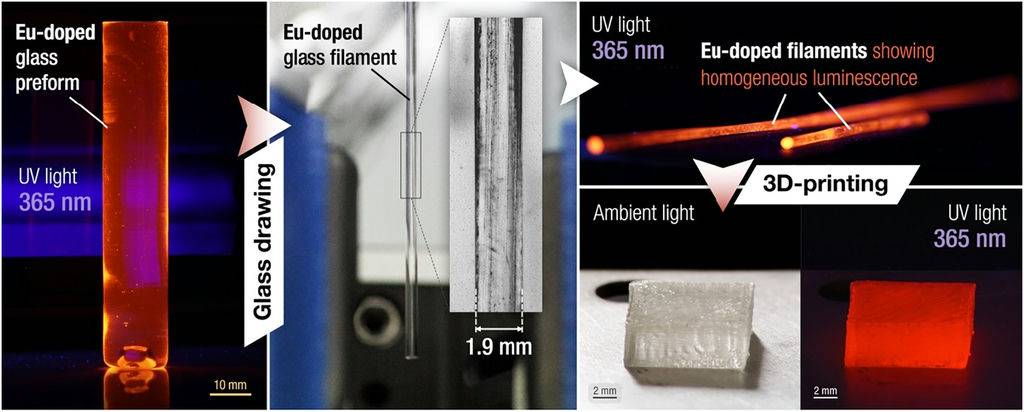Additive manufacturing of oxide glass enables on-demand, low-cost manufacturing of complex optical components for numerous applications, opening new opportunities to explore functionalities inaccessible otherwise. Here, we report a straightforward extrusion-based 3D-printing approach, deploying the fused deposition modeling (FDM) process, to produce optically transparent phosphate glasses with complex geometries and preserved structural and photoluminescence properties. Using a customized entry-level FDM desktop printer with a layer resolution of 100 μm, highly dense and transparent europium-doped phosphate glass structures can be fabricated from glass filaments pulled using a fiber-drawing tower from the parent glass preform. Combined with the suggested strategies for performance and quality improvement, professional-grade FDM printers can offer better layer resolutions. This direct approach for 3D-printing phosphate glass may open up new horizons not only for developing cutting-edge optical components but also for promoting new biomedical solutions upon making use of alternative biocompatible phosphate compositions.
In this work, the researchers have developed a glass 3D-printing approach based on fused deposition modeling (FDM), to produce highly dense, optically transparent phosphate glass parts with 100 μm layer resolution. Purely inorganic glass compositions have been successfully extruded and directly deposited layer-by-layer using a customized FDM printer. Overall glass properties, such as glass network structure, microstructural features, optical and luminescence properties have been well transferred from the bulk parent glass to the 3D-printed glass parts. The present 3D-printing system is currently being improved at several levels to increase the printing accuracy and guarantee the production of porosity-free, higher optical quality glass prints. A further detailed rheological investigation of the selected glasses, particularly the evolution of their viscosities with temperature and shear rate, will contribute in determining their respective working ranges for an optimized flow behavior through the printing nozzle.
Compared to other glass 3D-printing technologies, they propose a cost-effective, straightforward approach, offering a competitive tradeoff between simplicity of use and optical quality of the produced printed parts. This work enables the in-lab 3D-printing of fully functional glass parts, potentially finding applications for advanced optical systems. It could involve the direct 3D-printing of composite phosphate glass filaments incorporating high amount of rare-earths, metallic ions or nanoparticles, but also the 3D-printing of fully-densified, complex glass preforms subsequently pulled into optical glass fibers. Furthermore, it could benefit other areas such as medicine (e.g., controlled delivery of therapeutic or antibacterial ions upon 3D-printing biocompatible phosphate compositions, such as gallophosphate glasses, chemically close to the aluminophosphate materials presented herein, and extensively studied for their well-established antimicrobial activity.
Source: Direct 3D-printing of phosphate glass by fused deposition modeling. Authors: Reda MohammedZakiaClémentStrutynskiaSimonKaserabDominiqueBernardaGregoryHausscMatthieuFaesseldJocelynSabatiereLionelCanionifYounèsMessaddeqbSylvainDantoaThierryCardinala
a – CNRS, Univ. Bordeaux, Bordeaux INP, ICMCB, UMR 5026, F-33600 Pessac, France
b – Centre d’Optique, Photonique et Laser (COPL), Université Laval, QC, Québec, Canada
c- CNRS, Univ. Bordeaux, UMS 3626 PLACAMAT, Pessac F-33600, France
d- Bordeaux University, TechnoShop Coh@bit platform, Bordeaux Institute of Technology, 15 Rue Naudet, Gradignan 33750, France
e- Bordeaux University, IMS Lab., UMR 5218 CNRS, 351 Cours de la Libération, Talence 33405, France
f- Bordeaux University, CNRS, CEA, CELIA, UMR 5107, Talence F-33405, France



